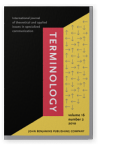Vol. 16:2 (2010) ► pp.181–216
Analysing the status of borrowed morphemes in terminological structure
The case of Japanese terminologies
Borrowed morphemes play an important role in Japanese terminologies. Though several investigations have dealt with the status of borrowed morphemes in Japanese terminologies, the status of borrowed morphemes within the structure of terminologies has not been fully addressed so far. In order to clarify the status of borrowed morphemes within the terminological structure, we introduce the concept of morphological network of terminology and investigate the status of morphemes within the network from the point of view of their conceptual versatility, conceptual prestige and the mixing degree between borrowed and native morphemes. Through the analyses of the terminologies of six domains, we shed light on aspects of the status of borrowed morphemes which have hitherto been unaddressed. The study also shows the general usefulness of the concept of morphological network in examining the status of different types of morphemes. With minor exceptions, it was revealed that the borrowed morphemes are used not only less frequently both typewise and tokenwise, but also have less conceptual versatility and conceptual prestige in comparison with native morphemes. We have confirmed that the borrowed and native morphemes are less mixed than would be expected if randomness was assumed.
Cited by
Cited by 2 other publications
This list is based on CrossRef data as of 9 june 2024. Please note that it may not be complete. Sources presented here have been supplied by the respective publishers. Any errors therein should be reported to them.
